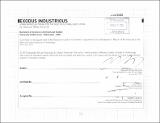| dc.description.abstract | Exodus Industrious has many beginnings, but few endings. Exodus Industrious is two parallel tales, told as one, which ultimately arrive at a critical moment in the history of the Americanism. Exodus is the story of capitalism and industry, and its antithetical decline which destabilizes a nation. Industrious is the story of the American Dream, a prodigal tale of the excess of Americanism, which was once rooted in a belief that if one possessed the characteristics of hard-work and self reliance, that they would ultimately reap the rewards of status, wealth, and power. Exodus Chronicles the rise and fall of the capitalistic state, while Industrious chronicles the industrious nature of the everyday American. The intersection of American industrial decline and the American dream, has prompted a new architectural vision of both. A vision which reacts to the failures of industry in solving societal problems, and the failure of the American Dream to sustain livelihoods. The vision seeks to mix the two, Industry and Domesticity, and recast them as an architectural solution to the problem which both have created. A rampant foreclosure crisis and skyrocketing unemployment. This new vision of the American Dream will be played out on a site in North East Detroit, in the Kettering Neighborhood. The Neighborhood is one of many which had been ravaged by the foreclosure crisis, as well as, the departure of a Major factory (The Packard Automobile Company) which would have once secured the livelihood of many of the residents of the Kettering Neighborhood, as well as, Detroit at Large. The proposal seeks to create an Anti-Capitalist Manufacturing Settlement, founded on the premise of Urban Revolution. The intention is to create four new Architectural Typologies Based on the Home, The Factory, The Warehouse and the Big-Box Superstore, which will attempt confront the political and social injustices which these typologies have arguably created, and propose a new interaction between them, which ultimately prompt a re-writing of the American Dream. We live in a nation in which 80% of the wealth is controlled by the top 5% of the populous, leaving the rest of us with no other option but Revolution. Revolution cannot be simply taken up as an occupation, or protest, it must be embodied via re-thinking the city, and re-assuming the right to the city, through the establishment of new architectural typologies. Architecture and Urban Space have the power to organize the masses, means of production, and the re-production of culture and through clever thinking, outside of the influence of capitalism, a new vision for the city can and must be envisioned. The intention of the thesis is to consider a new history, or a re-writing of an old one as the grounds for an architectural proposal. The American Dream and the rhetoric which surrounds it is the founding basis for action. The thesis seeks to examine the relationship between the single family home, manufacturing production, the maintenance of surplus value, and the distribution of commodities to a wider populous, while operating at the scale of a neighborhood of 3,000 - 5,000 people. | en_US |
